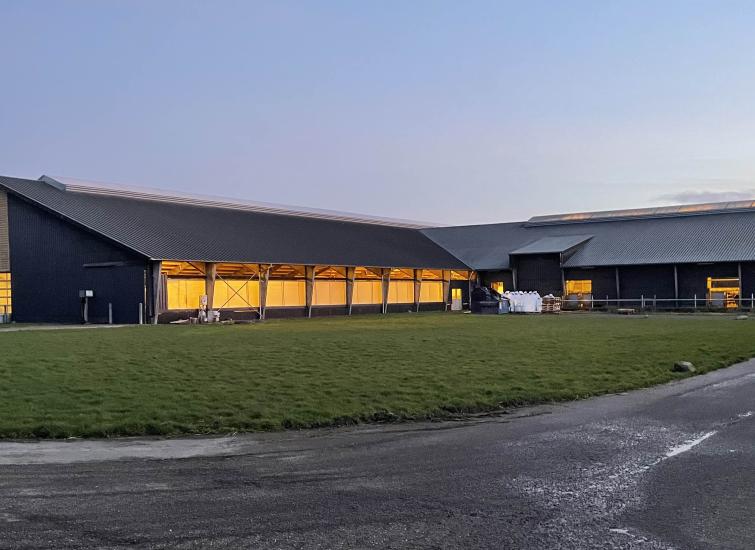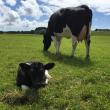Previous to Richard working with us we were struggling to get above 30/31 litres. Richard came in looked at the robot settings, the cow’s environment and nutrition. We saw an immediate response and an uplift in milk. We went from 31- 36 litres in very little time and it was down to Richard getting the diet right.
Advanced Nutrition Take a Jersey Innovation Tour
With the continent’s Jersey herds typically producing more milk than their UK counterparts, Eoghan Mullery investigates how UK farms can increase overall efficiencies as well as milk yield.

Last month, Eoghan Mullery, Technical Director at Advanced Nutrition led a group of Jersey farmers and nutritionists travelling to Denmark and Germany for the first in a series of tours to share knowledge with our friends on the continent. The team had an agreed agenda to look at milk, fertility and diet cost, with information and data being shared pre-visit so they could discuss findings and trends with the farm owner, vet and nutritionist in more detail.
Eoghan comments, “As a company, we’ve always been big on research as well as sharing of knowledge and ideas at a farm level. Our business has changed so much over the last five years. Our aim is not just increasing milk yields, (although that’s still important), but improving overall efficiency of the herds we work for, so that we can achieve and deliver targeted Key Performance Indicators, (KPI’s) for each different farm that we work with.”
“Our Total Digestion Management program was borne out of this idea and with the increasing pressure on farms to become more sustainable, we are constantly looking at new ideas to help move our farms forward. This time the trip was focused on Jersey herds and whilst we have shared and brought back a lot of knowledge for our Jersey customers, some of the key ideas that have come out of this process can be translated across all our farms,” explains Eoghan.
It's well recognised that Jersey herds in Denmark and Germany are often higher yielding and the group were interested to know whether their overall efficiency was better. The trip enabled a comparison of farming systems across a number of KPI’s, including yield, milk quality, fertility, transition and metabolic health, mobility and total cost of production. This comparison worked both ways and discussion on the farms was very much orientated towards sharing knowledge that was mutually beneficial. These discussions are ongoing with Advanced Nutrition and knowledge will be continually shared with Jersey herd owners.
Two highlights of the trip included a visit to the Østergaard and Adelgård Jersey herds in Denmark.
Østergaard Jerseys
Primarily a family business, the two brothers who now run this herd continued on from their father and have built up an impressive modern facility. Eight hundred Jerseys are milked twice a day on a fifty four point rotary parlour. They have eight full time employees.
Eoghan Mullery comments, “As well as looking at their nutritional approach we also looked at the forages they grew and took a focus on the cow management. Specifically, we looked at foot health and trimming protocols. This particular herd were trimming cows’ feet up to four times a year with an obvious focus on foot shape, so while the number of trims appears high, most trims were cosmetic foot health checks. This is an approach which some of our Advanced Nutrition herds are starting to adopt in the UK.”
Eoghan continues, “This herd rear all their own replacements whilst also selling approximately one hundred and fifty in calf heifers per year, predominately through the Danish Jersey society and many of them come here to the UK.”

Adelgård Jerseys
Adelgård is another family farm based in Denmark, with around three hundred and twenty Jersey cows milked twice a day on a thirty two point rotary parlour. This ultra modern unit houses the herd in a large shed on sand for cows and a separate shed for all the youngstock. They have four employees to do the milkings.
Eoghan Mullery comments, “This farm is probably the best farm I have seen with cows that are tremendous on their feet and legs, with excellent udders. This family are master breeders and have been for the last six years. The farm was spotless and a credit to the family – a mother and father and their two sons (one of whom is now employed off the farm).”
Eoghan continues, “Their attention to detail was amazing. The planning and detail that had gone into the design of housing and calving facilities was very impressive. The longevity of the cows was a major focus with the cows being batched in two groups. One group of younger cows and a group of older cows, all at different stages of lactation (i.e. they don’t have a fresh /mid or late group). The demand for the breeding of these cows meant that they would keep heifers and sell cows which kept the herd very young. A lot of the older cows with very high genetics were being nurtured through their lactations in the parlour, feeding for yield and body condition.”
Two main focuses for this farm are fertility protocols and heifer rearing. The voluntary waiting period (VMP) was typically 90 days which sparked a lot of discussion amongst the group.
Eoghan comments, “I was happy to see the Jersey herds embracing these longer VMP as with flatter lactations and with good management, the Jersey cow can typically thrive with a longer average lactation, achieving higher overall milk sold per lactation. It may not be possible on every herd, but I encourage Jersey herds in particular to challenge their thinking around VWP.”
“Heifer rearing at Adelgård is very impressive, (indeed it was impressive on all the farms we visited). This herd was utilising the original milking cow shed, which was still a fantastic facility. Light ridge, good ventilation, clean and well measured cubicles which were all retro fitted to suit the different growing stages. The result was an impressive uniformity amongst heifers. The farm has plans this summer to build a new purpose built calf barn. It really is testament to the fact that they (and farms across Denmark and Germany) appreciate that youngstock rearing is a key factor to future success and profitability.”
The group took some very valuable experience from seeing the focus on youngstock. During the visits, farmers, vets and nutritionists were just as keen to display the youngstock as they were the cows…a lesson we can perhaps learn more from in the UK!

Nutrition
Eoghan comments, “Having completed a detailed comparison looking at the key parameters of the diets between the visited farms and some high performing UK herds, it highlighted some expected and unexpected differences.”

“As expected, dry matter intakes were higher on average. Interestingly concentrate intakes were very similar without a huge difference in approach to the Advanced Nutrition fed herds in the UK (which we used in the comparison), who on average achieved 10,900kg on twice a day milking. So, with concentrate intakes similar, the extra intakes achieved is forage.”
Eoghan comments, “For me, this was the one key message to take home and to focus on over the coming months. We will further this research and compare things like grass varieties, maize varieties, slurry and fertiliser applications, reseeding policy, forage additives etc. used in both the UK, Denmark and Germany.”
“We were surprised to see maize harvested earlier than expected, typically focusing on overall plant digestibility and starch rather than just starch content. As with Advanced Nutrition herds in the UK, close attention is paid to amino acid balancing of the diets, as opposed to just crude protein. The use of protected fats and rumen buffers was more evident in Denmark than the UK with some good discussion around reasoning.” comments Eoghan.
Mobility and foot health management
The tour highlighted an impressive attention to detail around foot health. Eoghan comments, “It appears that there is an ingrained sense of importance for maintaining good foot shape and integrity, possibly this is partially reflected in better dry matter intakes. Perhaps the UK could learn from this and have a more open approach to three or even four foot trims or “inspections” per year. We focus a lot on mobility and foot health with our clients and I was very impressed with overall foot health on the herds we visited. There is a definite advantage being gained here!”
Further Research
The group took some valuable points from each farm and plans to meet again to discuss the salient points relevant to their own systems. Eoghan comments, “The key when you are experiencing different systems is to accurately identify which practice is most relevant to your herd. Just because a practice is working in Denmark, this doesn’t necessarily mean it will work on your farm in the UK, but at the same time we must challenge ourselves not to be blinkered by what we have always done.”
〈 BACK




